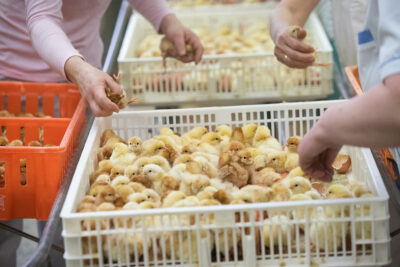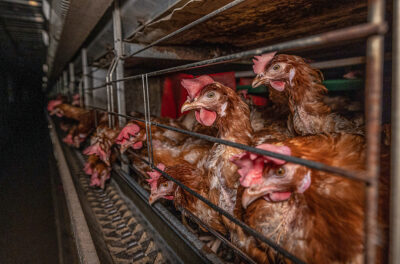Chicks are known for being cute, yellow, and fluffy. Their peeps have caused generations of people to smile.Yet for the billions of chicks raised to be sent to factory farms, life is grim. As soon as eggs are laid, they are taken from their mother and instead turned by machines. One day they hatch and are sent to farms, where they spend their whole short lives within an industrial production facility, often never seeing the light of day.
WHAT ARE THE FOUR STAGES OF HATCHING CHICKEN EGGS?
Every chicken starts in the same way: in an egg, laid by a mother hen. For the billions of chickens hatched in industrial farms, the rest of the story follows one of three paths depending on their breed and sex.
Broiler chickens, those raised for their flesh, are slaughtered a few weeks later, their bodies processed to end up on plates. Female layer hens, on the other hand, are fated to spend roughly a year in a shed laying eggs. These use up the calcium the layer hens need for their own bones, leading to a fragile skeleton and likely painful fractures. Male layer hens don’t live beyond their first day before being killed. Unable to lay eggs, or grow in the same way as broilers, they are viewed as a byproduct in the industry.
As impossible as it sounds, the vast majority of broiler chicken genetics are controlled by just three companies. The three entities, Cobb-Vantress, Aviagen, and Hubbard, are the only major companies focused on breeding broiler chickens. In 2022, Aviagen alone controlled 44 percent of the global market share of broiler chicken genetics.
Through dozens of generations, these companies have bred frankenchickens. These chickens grow at such a fast pace that their hearts and bones often can’t keep up, leading to issues with cardiovascular health and walking.
Regardless of whether a chicken egg is that of a layer or a broiler, the first days of their lives are very similar. Both eggs will be laid by mother chickens and then placed into an incubator where they will stay until they hatch. Once the chicks make their way out of the shell, they are sent to farms to face their fate.
THE EGGS ARE LAID
While most of the chickens bred commercially will head off to either a layer or broiler farm, a few are kept at breeder facilities and raised to lay the eggs that will become the next generation of chickens. Often their fate is just as bad as their offspring’s.
In layer hen breeding, about half of the chicks hatched are referred to as “sexing errors”. Each time birds are bred, only offspring of one sex are kept to continue. The other half, the “sexing errors”, are killed. Another welfare concern is that layer hen breeder birds also largely live in dim houses with light that is manipulated to maximise productivity.
The lives of broiler breeder birds are particularly awful. Due to generations of intentional breeding for production instead of welfare, their appetite is voracious. If given the same access to food as their offspring, they would eat so much that they would be unable to breed, and many would die from heart failure or other illnesses before reaching adulthood. To keep them alive long enough to breed, farmers only feed them a small amount of food. As a result of constantly feeling hungry, the chickens become grumpy, lashing out at each other. Instead of breeding chickens that do not suffer from such poor genetics, farmers opt to mutilate the parent birds by debeaking them — a process that includes clipping up to a third of their beak off.
THE EGGS ARE INCUBATED
Once laid, eggs are taken away from their mothers and placed into an incubator. Allowing mother hens to care for their young is not economically beneficial or practical to farms producing at such a massive scale, so instead they opt to mechanise the process.
Mother hens begin bonding with their chicks before their babies have even hatched. The day prior to hatching, chicks emit both sounds of distress when their mother is not present and sounds of pleasure when she is around. These vocalisations are likely to help with bonding and allow the chicks to identify their mother once they are hatched.
Communication between the baby birds and their mother ramps up once the chicks have made it out of their shells. The sounds emitted by the birds can range in purpose; some are calls from the mother for her offspring to follow. Her vocalisations increase when her chicks are stressed.
Like human mothers, hens also play a key role in teaching their offspring. Research has established that they fulfill all the requirements for educating their young: they change their behavior in ways that have no benefit for themselves and, as a result, their offspring alter their behavior accordingly, or learn the new behavior.
Chicks who are hatched and raised by their mothers have better welfare than those who are not. Despite this, on factory farms fertilised eggs are immediately taken away from mother hens to be incubated and hatched by machines.
WHAT IS THE DIFFERENCE BETWEEN AN INCUBATOR AND A HATCHER?
Once a fertilised chicken egg has been laid, it is first transported to an incubator, and later, shortly before hatching, to a hatcher. Each of these machines is a piece of specialised equipment that fulfils a unique role within the industry.
During the first several weeks, eggs sit in holes within an incubator that rotates them to prevent the embryos from adhering to the other contents of the egg. If they were to hatch in most modern incubators they would fall, as there is no basket or other flat surface on which to stand.
A couple of days before they are expected to hatch, eggs are transferred to the hatcher. At this point, the eggs no longer need to be rotated but they do need to have a temperature-controlled place to hatch, which is exactly what a hatcher provides.
THE EGGS HATCH
Once hatched, roughly half of all layer chicks are killed simply because they are male and thus unable to lay eggs. The genetic manipulation of chickens has resulted in two specific types of breed: chickens who grow very quickly and are raised for their flesh — known as broilers, and chickens who lay an astronomical number of eggs — layers.
Whereas broilers grow very large, very quickly, laying hens tend to stay fairly small, consume very little feed and lay hundreds of eggs every year. Because male layer chicks do not grow as quickly as broilers, the industry views them as a byproduct, not even worth what it would cost to feed and slaughter them for meat as adults.
There are several methods by which these chicks are slaughtered. Among them are asphyxiation in a gas chamber, maceration or “live shredding”, electrocution, suffocation and cervical dislocation or neck breaking.
HOW LONG DOES IT TAKE CHICKENS TO HATCH AT A HATCHERY?
Generally chicks hatch at around three weeks after being laid. Generally for the first 18 days they are in an incubator, before spending the last few in a hatcher.
In some instances the eggs will actually be hatched on the farm instead of at a hatchery. On-farm hatching has been linked to slightly improved welfare, including lower mortality rates and fewer occurrences of footpad dermatitis — painful sores on the feet.
THE CHICKS GO TO THE FARM
Those chicks who are being raised to be killed for their flesh will grow for six weeks until they reach a weight of up to 3.5kgs. Their swift growth rate is likely to lead to severe health consequences, including sudden death syndrome, leg abnormalities, and heart problems.
Once they are sent to the slaughterhouse, their suffering continues. Not only is transport an extremely stressful — and sometimes even deadly — experience, but the stunning prior to slaughter can be excruciating, with the process being made more painful for some birds by the leg abnormalities caused by their growth.
Stunning doesn’t always work, meaning that sometimes the chickens — who are less than two months old — experience several more minutes of agony at the slaughterhouse.
The female chicks who are sent to egg farms are compelled to lay hundreds of eggs every year. Their bodies often cannot keep up with the industry’s demands for long, and the hens are often considered spent after only two years.
In much of the world, layer hens spend their lives in a battery cage. These barren cages can house up to 10 birds at one time. Within the enclosure a hen doesn’t even have the space to extend her wings, much less follow her instinctive urge to build a nest for her eggs.
Traditional battery cages have been banned in a variety of countries. However, most places, including the UK, allow for enriched cages. So-called enriched cages are very similar to traditional battery cages but provide some wood for perching and a scratching pad.
WHAT ARE THE BASIC REQUIREMENTS FOR A HATCHERY?
Hatcheries are necessary due to the industrial raising of chickens for eggs and meat. Because so many chickens are raised within these industries, there is no way for eggs to be left with their mothers to take care of them. For this reason, hatcheries that provide the necessary environmental factors for eggs to hatch are used to bridge the gap and meet the demand for chicks from the two industries.
CONCLUSION
Hatcheries represent just the first step of a life of suffering for the billions of chickens raised for meat and egg production around the world. From the moment they are laid, fertilised eggs and the embryos they contain have every aspect of their lives controlled in the name of profit.
The situation remains the same when they are transported to their final home: the factory farm. Here their suffering is multiplied tenfold. The best way not to contribute is to stop driving demand and choose vegan foods instead.





